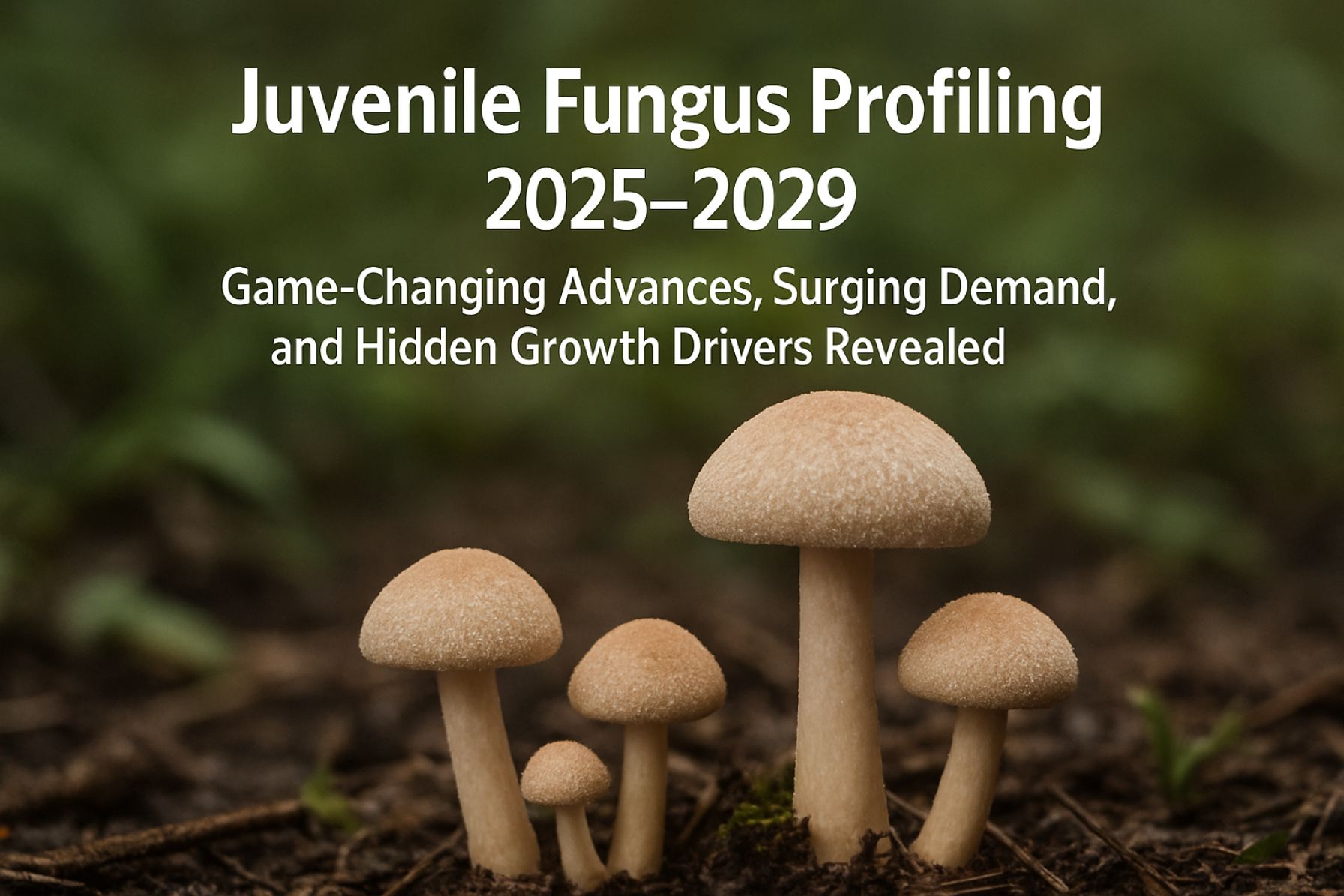Table of Contents
- Executive Summary: Why Juvenile Fungus Profiling Matters in 2025
- Market Size and Forecast: Growth Projections Through 2029
- Key Drivers: Emerging Applications and Untapped Opportunities
- Technology Landscape: Breakthrough Methods and Tools
- Competitive Analysis: Major Players and Strategic Initiatives
- Regulatory Environment and Industry Standards
- Applications: Agriculture, Medicine, and Environmental Uses
- Challenges and Risk Factors in Juvenile Fungus Profiling
- Investment Trends and Funding Outlook
- Future Outlook: Innovations and Long-Term Industry Impact
- Sources & References
Executive Summary: Why Juvenile Fungus Profiling Matters in 2025
Juvenile Fungus Profiling is emerging as a pivotal discipline in mycology and agricultural biotechnology, with 2025 poised to mark significant advancements in both methodology and industry adoption. This field involves the identification and characterization of fungi at their early developmental stages, providing critical insights into fungal life cycles, pathogenicity, and environmental adaptation. Its growing relevance is fueled by expanding applications in crop protection, food security, environmental monitoring, and pharmaceutical discovery.
Recent years have witnessed considerable investment in high-throughput sequencing and metabolomic platforms, enabling precise juvenile stage profiling. In 2025, leading agricultural biotech firms and research institutions are leveraging these technologies to accelerate the detection of plant-pathogenic fungi. For example, BASF and Syngenta are integrating juvenile profiling into their R&D pipelines to develop more targeted fungicides, reducing time-to-market and improving yield outcomes. This data-driven approach supports the identification of resistance traits and the mapping of fungal population dynamics in real time.
The outlook for the next few years suggests further integration of AI-powered analytics with juvenile profiling datasets, as industry leaders such as Corteva Agriscience and Bayer AG invest in machine learning to predict emergent fungal threats and optimize intervention strategies. Additionally, governmental and non-governmental organizations are recognizing the value of early-stage fungal insights for global food safety. The Food and Agriculture Organization of the United Nations (FAO) has highlighted the need for advanced pathogen surveillance systems, with juvenile profiling positioned as a core component of future food security frameworks.
In pharmaceuticals, juvenile profiling is expediting the discovery of novel bioactive compounds, as organizations like Novozymes explore fungal metabolites for new antibiotics and enzymes. Furthermore, environmental agencies are deploying these techniques for biodiversity assessments and invasive species management, underscoring broad interdisciplinary value.
In summary, the maturation of Juvenile Fungus Profiling in 2025 signifies a paradigm shift: it is no longer a niche research tool, but a strategic necessity across agri-biotech, pharma, and environmental sectors. With continued technology integration and cross-sector collaboration, the next few years will see its influence expand, driving innovations that underpin sustainability, productivity, and global health.
Market Size and Forecast: Growth Projections Through 2029
The market for juvenile fungus profiling is on the cusp of significant expansion, shaped by advances in molecular diagnostics, agricultural biotechnology, and increasing global emphasis on early-stage fungal disease management. As of 2025, the sector is characterized by a surge in demand from industries such as crop science, forestry, and environmental monitoring, all seeking precise identification and characterization of fungal populations at early life stages.
Key drivers include the adoption of next-generation sequencing (NGS) and quantitative PCR (qPCR) platforms, which enable high-throughput, cost-efficient profiling of juvenile fungi in complex biological and environmental samples. Major players such as Thermo Fisher Scientific and QIAGEN have expanded their product lines to include dedicated kits and software for fungal DNA analysis, specifically optimized for immature fungal forms. These tools are increasingly integrated into workflows for seed health testing, soil microbiome analysis, and plant disease surveillance.
In terms of market size, estimates for 2025 indicate global revenues in the low hundreds of millions USD, with compound annual growth rates (CAGR) projected between 10% and 14% through 2029. This growth is underpinned by the rising frequency and severity of fungal outbreaks in agriculture and forestry, prompting regulatory agencies and industry bodies such as the Centre for Agriculture and Bioscience International (CABI) to emphasize early detection and profiling of juvenile fungal threats. The market is also benefiting from collaborations between technology providers and research institutes focused on standardized protocols and data sharing.
The outlook for the next few years is marked by increasing automation and miniaturization of profiling platforms, with companies like Illumina and Bio-Rad Laboratories investing in portable, field-deployable solutions. These advancements are expected to accelerate adoption in resource-limited settings and facilitate real-time monitoring of juvenile fungal populations. Additionally, the integration of AI-driven analytics for predictive modeling and risk assessment is anticipated to further differentiate offerings and expand use cases.
Overall, the juvenile fungus profiling market is poised for robust growth through 2029, with sustained innovation, broader application scope, and regulatory momentum driving both the expansion of core markets and the emergence of new customer segments.
Key Drivers: Emerging Applications and Untapped Opportunities
Juvenile fungus profiling—targeted analysis of fungal species during their early developmental stages—is rapidly garnering attention across biotechnology, agriculture, and pharmaceutical sectors. In 2025, several key drivers are propelling this field, with a notable surge in both emerging applications and identification of untapped opportunities.
- Precision Agriculture and Crop Protection: As global agriculture intensifies its focus on sustainable practices, the early detection and profiling of pathogenic fungi in juvenile stages is emerging as a game-changer. Leading crop science companies are investing in molecular profiling tools to identify harmful fungi before outbreaks, enabling tailored interventions and reduced chemical use. For example, Syngenta is integrating fungal genomics with its digital agriculture platforms, while Bayer AG is collaborating on advanced diagnostics to distinguish between pathogenic and beneficial juvenile fungi in crop soils.
- Pharmaceutical Discovery and Mycobiome Research: The juvenile stages of fungi often produce unique metabolites and secondary compounds of potential therapeutic value. In 2025, biotech firms like Ginkgo Bioworks are utilizing high-throughput sequencing and metabolomics to profile juvenile fungal communities, seeking novel antimicrobial or immunomodulatory agents. This is complemented by a growing academic and commercial interest in mapping the human mycobiome, particularly in neonates and pediatric populations, to uncover links to health and disease.
- Food Safety and Spoilage Prevention: In food processing, early-stage fungal profiling is being adopted to prevent spoilage and contamination. Companies such as DSM-Firmenich are developing rapid DNA-based assays for the detection of spoilage fungi in dairy and bakery products, aiming to extend shelf life and assure safety.
- Environmental and Conservation Biology: Conservationists and environmental agencies are increasingly interested in profiling juvenile fungi to monitor ecosystem health and biodiversity. Organizations like the Royal Botanic Gardens, Kew have launched initiatives to catalog juvenile fungal species in threatened habitats, informing restoration and conservation strategies.
Looking forward, the outlook for juvenile fungus profiling is shaped by ongoing advances in genomics, AI-driven data analysis, and portable sequencing devices. The next few years are likely to see broader industrial adoption, with new applications in biofertilizers, ecosystem restoration, and even sustainable biomaterials. As cost barriers continue to fall and databases expand, the untapped potential of juvenile fungal stages is expected to unlock new pathways across science and industry.
Technology Landscape: Breakthrough Methods and Tools
Juvenile fungus profiling—the characterization and identification of fungal species at early developmental stages—has rapidly advanced due to breakthroughs in genomics, imaging, and bioinformatics. In 2025, industry and academia are leveraging these innovations to address challenges in agriculture, pharmaceuticals, and food safety, where early detection of fungal pathogens or beneficial strains is crucial.
One significant technological leap is the adoption of portable, real-time DNA sequencing platforms. Devices such as the MinION, developed by Oxford Nanopore Technologies, have enabled rapid, field-based sequencing of juvenile fungal samples. These platforms allow direct analysis without the need for extensive laboratory infrastructure, accelerating identification and tracking in both agricultural and clinical environments. Their utility in profiling plant pathogens is already being demonstrated in collaborative projects with agricultural agencies and plant health authorities.
High-throughput phenotyping, coupled with automated image analysis, is also transforming juvenile fungus profiling. Companies like LemnaTec GmbH offer imaging systems that capture detailed morphological changes during early fungal growth. These systems use AI-driven software to distinguish subtle differences in spore germination, hyphal branching, and colony formation, providing an objective basis for early-stage profiling and classification.
Metabolomics is an emerging tool for distinguishing fungal species and strains during their juvenile phases. Bruker provides mass spectrometry platforms capable of detecting unique metabolite signatures in fungal cultures, facilitating early discrimination between pathogenic and non-pathogenic isolates. These platforms are increasingly integrated into laboratory workflows, especially in pharmaceutical R&D, where juvenile profiles can inform screening for novel bioactive compounds.
As regulatory and quality standards evolve, standardized juvenile fungus profiling is becoming essential in food and agriculture supply chains. Organizations such as the United States Department of Agriculture (USDA) are piloting new protocols for early pathogen detection, combining molecular diagnostics with digital data management. These initiatives aim to reduce crop losses and ensure food safety by enabling intervention at the earliest possible stage.
Looking forward, the convergence of multi-omics data (genomics, transcriptomics, metabolomics) and machine learning is expected to further refine juvenile profiling methods. Industry leaders are investing in cloud-based platforms for collaborative data analysis and sharing, setting the stage for real-time, globally coordinated fungal surveillance. With these advances, juvenile fungus profiling will become a cornerstone technology in preemptive pathogen management and biotechnological discovery by the late 2020s.
Competitive Analysis: Major Players and Strategic Initiatives
The competitive landscape for juvenile fungus profiling is evolving rapidly in 2025, characterized by strategic collaborations, technological advancements, and increased investment in next-generation sequencing and bioinformatics platforms. Major players are focusing on expanding their profiling capabilities to meet growing demand for early-stage fungal identification across agriculture, environmental monitoring, and biomedicine.
Key industry participants include Thermo Fisher Scientific Inc., QIAGEN N.V., and Illumina, Inc., all of which have recently expanded their fungal genome sequencing portfolios. For instance, Thermo Fisher has introduced workflow enhancements to its Ion Torrent sequencing system that allow for higher sensitivity in detecting juvenile fungal species, aiming to support both research and agricultural pathogen management initiatives. QIAGEN has updated its QIAseq solutions to improve the efficiency of low-biomass fungal DNA extraction, directly addressing challenges in profiling early-stage fungal colonies.
Strategic partnerships are shaping the market. In 2024, Thermo Fisher Scientific Inc. and International Society for Animal and Plant Genomics collaborated to launch a pilot project leveraging metagenomics for profiling soil-borne juvenile fungi in commercial crop systems. This project’s ongoing results are expected to influence agricultural best practices by 2026. Meanwhile, Illumina, Inc. is working closely with environmental research institutions to develop targeted sequencing panels for rapid juvenile fungus identification, aiming for broader deployment in ecosystem monitoring by 2027.
Startups are also gaining traction, notably Pure Enzymes Inc., which has developed an AI-driven platform integrating image-based and genomic data for early fungal profiling in food production facilities. This technology, currently being piloted with select multinational food manufacturers, underscores the increasing role of machine learning and automation in the field.
Outlook for the next few years indicates heightened competition, with major players likely to further integrate automation, AI analytics, and cloud-based data sharing into their juvenile fungus profiling offerings. This evolution is expected to reduce turnaround times and enhance accuracy, supporting both routine screening and outbreak response. Industry alliances and investments in R&D will continue to drive innovation, with a strong emphasis on scalable, field-deployable solutions for both laboratory and on-site applications.
Regulatory Environment and Industry Standards
The regulatory landscape for juvenile fungus profiling is evolving rapidly in 2025, reflecting increased global attention to food safety, agricultural biosecurity, and environmental health. Regulatory agencies are now prioritizing the early detection and identification of fungal species—especially those in juvenile stages—due to their relevance in crop contamination, spoilage control, and emerging pathogen tracking.
In the United States, the United States Department of Agriculture (USDA) has updated its guidelines for fungal pathogen surveillance, underscoring molecular and genomic profiling for early-stage detection. These updates are largely driven by the need to counteract mycotoxin-producing fungi, such as Aspergillus and Fusarium species, at juvenile phases before widespread contamination occurs. The USDA’s Plant Protection and Quarantine (PPQ) division now recommends the use of advanced PCR-based methods and next-generation sequencing (NGS) platforms for juvenile fungus identification in both field and post-harvest environments.
On an international scale, the International Plant Protection Convention (IPPC) is in the process of revising its standards for fungal pathogen monitoring. In 2025, the IPPC’s draft guidance emphasizes harmonized protocols for juvenile fungus profiling, aiming for global consistency in sample collection, DNA extraction, sequencing, and data interpretation. This is designed to facilitate cross-border cooperation on invasive species and plant disease management.
Industry standards are simultaneously advancing. Organizations such as ISO are working towards formalizing standardized methods for the molecular profiling of juvenile fungi, with a focus on reproducibility and traceability of results. Draft ISO standards for fungal DNA barcoding and metagenomic analysis in agricultural matrices are expected to move toward ratification in late 2025 or early 2026. These standards will underpin quality assurance for commercial diagnostics, seed certification, and biosecurity screening.
On the industry side, major suppliers of fungal detection technologies, such as Thermo Fisher Scientific and QIAGEN, are actively collaborating with regulatory bodies to ensure their profiling kits meet new compliance criteria. Their platforms are being validated for use under both USDA and EU regulatory frameworks, reflecting the growing demand for harmonized, internationally recognized testing protocols.
Looking ahead, regulatory momentum is expected to continue, with a strong outlook for integrated digital platforms combining juvenile fungus profiling data with real-time reporting to national and international authorities. This integration is anticipated to streamline compliance and improve rapid response to fungal threats across food systems and ecosystems over the next several years.
Applications: Agriculture, Medicine, and Environmental Uses
Juvenile fungus profiling—the identification and characterization of fungi at early developmental stages—has rapidly gained traction across agriculture, medicine, and environmental management as of 2025. This approach leverages advances in genomics, phenotyping, and bioinformatics to offer early insights into fungal populations, supporting proactive interventions and innovative applications.
In agriculture, early-stage profiling allows for the detection of pathogenic fungi before they cause crop losses. Companies like Syngenta and Bayer AG have integrated juvenile fungus profiling into their crop protection pipelines, using molecular assays and next-generation sequencing to monitor soil and plant samples for emerging threats such as Fusarium and Botrytis. In 2024-2025, these companies reported field trials where early detection led to targeted fungicide application regimes, minimizing chemical use and improving yields. Furthermore, juvenile fungus profiling is facilitating the screening of beneficial fungi—such as Trichoderma and mycorrhizal species—for biofertilizer and biocontrol product development, with firms like Valagro showcasing new inoculants tailored to specific crop-fungal interactions.
Medical applications are expanding as hospitals and diagnostic laboratories increasingly profile juvenile forms of pathogenic fungi, such as Candida and Aspergillus, to inform infection management. bioMérieux and Thermo Fisher Scientific have released updated molecular panels capable of detecting fungi at early infective stages, enhancing the speed and accuracy of clinical diagnostics. The ability to identify fungal species before overt symptoms manifest is projected to improve patient outcomes and reduce nosocomial infection rates through timely intervention, as highlighted in collaborative projects with reference microbiology centers.
Environmental uses are also evolving, with juvenile fungus profiling underpinning ecosystem monitoring and restoration. Organizations such as U.S. Geological Survey (USGS) have begun utilizing early-stage fungal community assessments to track soil health and biodiversity recovery in post-disturbance landscapes. These efforts are complemented by biotechnology firms like Novozymes, which are developing consortia of beneficial fungi for bioremediation and carbon sequestration, supported by high-resolution juvenile profiling to ensure optimal strain selection and establishment.
Looking ahead to 2026 and beyond, integration of AI-driven analytics, real-time sequencing, and field-deployable biosensors is expected to further refine juvenile fungus profiling, with cross-sector collaborations accelerating technology adoption and standardization. The outlook points to increased precision and sustainability in agriculture, personalized approaches in medicine, and robust tools for ecological stewardship.
Challenges and Risk Factors in Juvenile Fungus Profiling
Juvenile fungus profiling, the process of accurately identifying and characterizing immature fungal forms, is gaining momentum as a critical component in mycology, agriculture, and clinical diagnostics. As the demand for early detection of pathogenic fungi and comprehensive biodiversity assessments increases, several challenges and risk factors have emerged, particularly as the sector advances in 2025 and anticipates further developments in the near future.
One of the foremost challenges lies in the morphological similarities among juvenile stages of different fungal species, which often leads to misidentification. Traditional morphological keys are optimized for mature specimens, making it difficult for mycologists and laboratory technicians to rely solely on visual cues for accurate classification. This limitation has prompted a surge in adopting molecular-based identification techniques, such as next-generation sequencing (NGS) and polymerase chain reaction (PCR), to enhance specificity and sensitivity. However, these advanced methods present their own set of obstacles: PCR inhibitors found in environmental samples can reduce accuracy, and the high costs and technical expertise required for NGS remain prohibitive for many laboratories, particularly in resource-limited settings (Thermo Fisher Scientific).
Another risk factor involves the incomplete reference databases for juvenile fungal forms. Most genetic databases are biased toward mature fungi, leaving significant gaps in the genomic information necessary for reliable juvenile identification. This data deficiency not only hampers research but also limits the effectiveness of disease management programs in agriculture and public health. Efforts are underway to expand these databases, such as the initiatives by ATCC to include more comprehensive fungal strain collections, yet progress is gradual, and gaps persist.
Sample contamination and preservation present further challenges. Juvenile fungi are often more susceptible to environmental degradation and microbial contamination during sampling and storage. This risk is amplified in field conditions, where rapid processing is not always feasible. Manufacturers like Sartorius AG are developing improved sample collection and preservation kits, but scalability and ease of field use remain areas for improvement.
Looking forward, the outlook for juvenile fungus profiling hinges on the integration of AI-driven image analysis and portable molecular diagnostics, which are expected to become more accessible. Industry leaders are collaborating on digital platforms for real-time data sharing and cross-validation, as seen in recent partnerships between laboratory suppliers and research institutions. Despite these advancements, the sector must address the persistent challenges of database gaps, contamination risks, and accessibility to ensure robust and reliable juvenile fungus profiling in the coming years.
Investment Trends and Funding Outlook
The field of juvenile fungus profiling—comprising the identification, characterization, and monitoring of fungal species at early developmental stages—is emerging as a promising niche within broader agricultural biotechnology and mycology sectors. In 2025, investment trends reflect a growing recognition of the role that juvenile fungal profiling plays in crop protection, yield optimization, and ecosystem health.
Several specialized biotechnology firms and agricultural technology startups have secured early-stage and Series A funding rounds to develop next-generation diagnostic platforms targeting juvenile fungal pathogens. For example, Syngenta has announced strategic investments in digital diagnostics and precision agriculture platforms that include fungal profiling modules, aiming to deliver actionable data to growers for early intervention and integrated pest management.
Similarly, Bayer AG’s Crop Science division has increased its research and development budget for 2025, with a portion earmarked for rapid pathogen detection technologies. These initiatives often involve partnerships with academic consortia and industry bodies, such as collaborations with the International Maize and Wheat Improvement Center (CIMMYT) to pilot early detection tools in field trials.
On the instrumentation front, companies like Thermo Fisher Scientific and QIAGEN are channeling resources into the development of portable sequencing and PCR-based platforms tailored for rapid, on-site juvenile fungus identification. These investments are complemented by announcements of expanded product portfolios and targeted acquisitions of smaller mycology-focused startups.
Public funding is also playing a role. The U.S. Department of Agriculture (USDA) and the European Forest Institute (EFI) have issued new grant calls in 2024–2025 for research into forest and crop health monitoring, explicitly mentioning the need for improved profiling of fungal threats at early life stages. This public-private synergy is expected to accelerate commercialization pipelines over the next few years.
Looking ahead, the outlook for investment in juvenile fungus profiling remains positive. The convergence of digital agriculture, molecular diagnostics, and environmental monitoring is likely to drive further funding, especially as climate change intensifies the threat of emerging fungal pathogens. As regulatory frameworks adapt to these technological advances, stakeholders anticipate robust growth in both private and public investment, supporting the deployment of scalable juvenile fungus profiling solutions worldwide.
Future Outlook: Innovations and Long-Term Industry Impact
The future outlook for juvenile fungus profiling is poised for significant innovation and broad industry impact as mycological research, agriculture, and biotechnology sectors increasingly recognize the value of early-stage fungal identification. In 2025, rapid advances in genomic sequencing, AI-driven image analysis, and portable diagnostic technology are transforming the profiling of juvenile fungal stages—those critical early phases in the fungal lifecycle where morphological identification is most challenging.
Leading edge technologies such as nanopore sequencing and CRISPR-based diagnostic assays are enabling faster and more precise detection of fungi at juvenile stages. For instance, portable sequencing devices developed by Oxford Nanopore Technologies allow field scientists to identify fungal DNA within hours, substantially reducing the delay between sample collection and actionable data. This real-time capability is especially valuable for monitoring emerging plant pathogens or tracking beneficial fungi in soil restoration projects.
Agricultural stakeholders are investing in digital phenotyping platforms that combine high-resolution imaging with AI algorithms to detect and differentiate juvenile fungal colonies before they become macroscopically visible. Companies like Bayer are integrating such platforms into crop protection programs, leveraging early profiling to inform targeted fungicide application and resistance management strategies. This approach not only promises to reduce chemical inputs but also enhances sustainability and crop yields.
In the next few years, the integration of juvenile fungus profiling into broader environmental and food safety frameworks is anticipated. For example, the United States Department of Agriculture is funding research to develop early-detection tools for foodborne and post-harvest fungal pathogens, aiming to cut economic losses and safeguard public health. Simultaneously, biotechnology firms are exploring the use of juvenile profiling to accelerate the discovery and commercial deployment of beneficial fungi as biocontrol agents and biofertilizers.
Long-term, these innovations are expected to reshape how industries manage fungal threats and opportunities. Streamlined juvenile profiling will underpin more responsive disease surveillance networks, facilitate regulatory compliance, and drive the development of new fungal-derived products. As interoperability with cloud data platforms and remote sensing technologies increases, the granularity and scale of fungal monitoring will expand, positioning juvenile fungus profiling as a foundational tool for sustainable agriculture, ecosystem management, and biomanufacturing through the latter part of this decade.
Sources & References
- BASF
- Syngenta
- Corteva Agriscience
- Food and Agriculture Organization of the United Nations (FAO)
- Thermo Fisher Scientific
- QIAGEN
- Centre for Agriculture and Bioscience International (CABI)
- Illumina
- Ginkgo Bioworks
- DSM-Firmenich
- Royal Botanic Gardens, Kew
- Oxford Nanopore Technologies
- LemnaTec GmbH
- Bruker
- International Plant Protection Convention
- ISO
- bioMérieux
- ATCC
- Sartorius AG
- International Maize and Wheat Improvement Center (CIMMYT)
- European Forest Institute (EFI)









